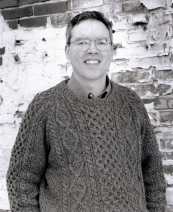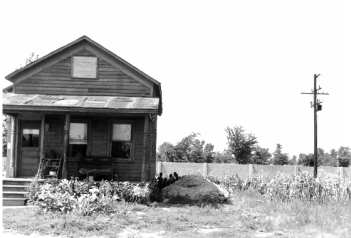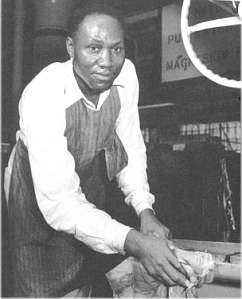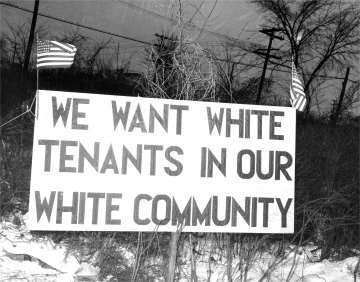Zelizer: What was the neighborhood? Sugrue: I grew up on the city's northwest side. It was a typical neighborhood of modest houses built in the 1920s and the 1940s and between 1970 and 1973, in a period of about 3 1/2 years, the neighborhood went from being all white to being almost all African American—something that at the time as a naive child I viewed as racial integration because I was there as the neighborhood was in the process of transformation but later realized was just a very short stepping stone between all white segregation to all black segregation. So it was an interesting process of really dramatic transformation in a very short period of time. Zelizer: Had your family been in the neighborhood for a while? Sugrue: Yes. My parents had purchased a house in this neighborhood in 1962, just before I was born, and had lived there for about ten years when they followed the great white migration out of the city to the suburbs. Zelizer: In your book, you thank your aunt, Jane Sugrue Ryan, who you call your "intellectual role model" and "political comrade." I was wondering if you could tell us who she was? Sugrue: Oh, well, my Aunt Jane would be proud to know that she is being discussed on the radio but Jane, Jane was a Catholic nun until she was in her fifties. She was a member of the Sisters of Mercy which in the world of Catholic religious orders tend to be pretty far to the left. And Jane was also one of the few members of my Dad's side of the family to have gone through college. In fact, she went on to get advanced degrees as well. And so she was someone that was—both in terms of her commitment to issues like social justice and the fact that she was the resident intellectual in our family—was someone that I relied a lot on for intellectual support and sustenance in growing up. Zelizer: And then you went to graduate school at Harvard? Sugrue: Right. Zelizer: And who was your mentor there? Sugrue: Ah, well I worked with Steven Thernstrom in the History Department and Barbara Rosenkrantz who was in the History of Science Department. Zelizer: And in graduate school were there any books, or people in the university, who inspired you or who kind of stimulated where your work would go in this book? Sugrue: Yes. I would say probably not that many. I mean, that is, Harvard is a place where graduate students fend for themselves. You create your own topic, you don't get a lot of support and guidance from your mentors, and you more or less do it yourself. And I was writing on 20th-century American history, and as a 20th-century American historian you know that the field is still very unformed. It's one that is in the process of defining itself. And most major graduate programs, when I was in graduate school in the mid and late 1980s, didn't have senior 20th-century American historians on the faculty. So those of us who were forging ahead in 20th-century history at Harvard did it more or less by the seat of our pants. Talking to, in this case, some junior faculty who were there, people like Eric Arnesen and Brian Balogh, but also just making connections hither and dither where I could find folks who I could talk to about my work. So when I was in the archives in Detroit, I stumbled into a superb 20th-century historian, Nelson Lichtenstein, who was at that time writing a biography of Walter Reuther. And so, he became someone I could bounce ideas and get some feedback from as I was working on my project. Zelizer: Were there other books, though, that shaped how you were thinking about the 20th century? Sugrue: Yes. I would say given the topic, writing about cities and writing about social policy and public policy, I was influenced strongly by the work of sociologists. Sociologists cornered the market on the field in the 1980s and a really important book came out just as I was formulating my dissertation topic which was William Julius Wilson's, The Truly Disadvantaged. Wilson, probably the leading urban sociologist and scholar of African Americans in the field of sociology, was at the University of Chicago at the time and wrote a really important study of urban poverty based on field research and studies of the census and demography in Chicago. Wilson's book is a book that in some ways is like the Bible. You can pick and choose from it what you want depending on what place you occupy in the contentious debates about poverty. The part of Wilson that excited me was his discussion of the importance of job loss, deindustrialization, to the fate of the poor. The part of Wilson that frustrated me as an historian was that he, like most sociologists and social policy people writing about urban poverty, started their story more or less in 1970 or some time in the 1960s. And as an historian, I wanted to bring a little more depth and perspective to a literature that focused largely on the period following the 1960s and that gets into, in some ways, some of the larger interpretive themes of my book. I'm in part not just engaging the work of sociologists but really trying to offer a corrective to historians who focus on the period of the 1960s as being this great apocalypse. This moment of profound transformation and don't look at the really important connections between what was going on in the 1940s and '50s with what happened in the '60s and beyond. So I'm really addressing the work of sociologists who are writing about urban poverty but also trying to correct historians who, I think, fall back on hoy clichés and shibboleths about America in the 1940s, '50s, and '60s. Zelizer: Could you tell us a little more about the themes of your book [The Origins of the Urban Crisis] for listeners who may might not have read it yet? Sugrue: Yes. My book is really an attempt to intervene in debates about poverty and social policy by making an argument that we can't lay the blame for the persistence of urban poverty on the social programs of the 1960s. The conservative argument being that the Great Society unleashed welfare dependency and exacerbated the problem of poverty. That we really need to look at a combination of forces that were transforming the American urban landscape unheralded as early as the 1940s and 1950s. Three forces transformed American cities in this period. One was the flight of jobs, capital flight, and you see this certainly in this area and in Detroit and many other parts of the country and the rotting hulks of giant factory buildings that have been abandoned by industry over the last half century or so. So, the loss of jobs is one. Second, is persistent racial discrimination in the workplace. Despite the gains of the Civil Rights Movement, which were consequential and important, despite the opening of job opportunities to African Americans there still remained persistent and really frustrating discrimination across industries that had a significant impact on the economic opportunities of blacks, in particular. And the third, and this remains in some ways the most vexing and unresolved problem in race relations in 20th-century America, is residential segregation by race. And there remains in most Northern cities a degree of residential separation between blacks and whites that would have made the architects of Jim Crow in the South happy. That is, the vast majority of whites live in all white communities, the vast majority of African Americans live in African-American communities that have been subject to depopulation and disinvestment. The story of segregation was one that I knew about in the abstract, but wasn't really able to get at the inner workings of the process of segregation through my research in Detroit. And I found it was a combination of government policy, that is, federal subsidies to whites who were moving to the suburbs and to developers who were building communities for whites in suburban areas. The actions of real estate brokers who played a crucial role in stirring up fears of racial integration among white homeowners and an enormous grass-roots movement of working-class and middle-class whites who fought intensely to preserve the racial homage in 80 of their neighborhoods. So, in Detroit in this period—and I've subsequently through research found that this is true for many other cities in the North as well—there was an intense pattern of violent attacks on the first blacks to move into formally white neighborhoods. I found through digging, you know, rooting through all sorts of obscure records that there were more than 200 violent incidents in Detroit between the mid-forties and mid-sixties targeted against the first black families to move into formally all white neighborhoods. And so there was grass-roots resistance that drew invisible lines of race on the city's landscape and enforced them both to protest in political action but also through window breaking, arson, and attacks on black homeowners. Zelizer: Now when you started the project it was in Harvard as a dissertation. How did you select Detroit as the place that you would look at these issues? Sugrue: Yes, I selected Detroit, in part, I think because of personal biography. That is, I wanted to understand the place that I had grown up in. I also decided to focus on it because Detroit was, in the 1940s, a symbol of American industrial power at its peak. This was a place that was visited by Europeans and Asians, people coming to the United States to see how American capitalism worked. It was the pinnacle of American power. It was the arsenal of democracy during World War II. Yet, by the 1960s and 1970s Detroit had become a symbol of America's urban crisis. It was a city ravaged by one of the most violent racial disturbances of the 20th century, the uprising of 1967. It was a city that lost most of its white population to suburbanization and it became, in many respects, an emblem of America's urban crisis. So Detroit in some ways was an ideal type. It allowed me to look at a symbol of America at its most prosperous and affluent and a symbol of American cities at their most troubled, all within 300 short pages. Zelizer: But when you start, I mean you start in the 1940s—the New Deal looms large—and in your book there's a quote that the "New Deal was riddled with ambiguities and contradictions that led to tensions in post-war Detroit," racial tensions. I was wondering if you could talk a little bit about the role of the New Deal in shaping the history that you wrote about?
Zelizer: You said it wasn't always the intent of people in Washington, so how did it happen? Did it just fall into the existing patterns of Detroit social life or were there political forces actively pushing to inflect, or erase racial . . .
Zelizer: Were there forces for more progressive change maybe from the unions in that time period?
Zelizer: As you wrote this how did you find these things out? What kind of sources did you use? Or materials? Sugrue: I rooted around in all sorts of different sources. Telling a story like the story that I tell is difficult. It's not like, say, writing a political biography or, as I've done recently' an article based on presidential archives where everything is laid out in one collection. It's very neat and orderly. I relied on obscure neighborhood newspapers, some of which came from somebody's garage miraculously to an archive in the middle of my research. They were moldy and damp still, many of them. I relied on the papers of unions, of employers, where I could find them, of civil rights organizations, like the NAACP and the Urban League, on the papers of individuals. I stumbled across an amazing collection that was of a black woman neighborhood activist in the 1940s and 1950s who had donated them to the Detroit Public Library and then allowed me to tell a really great story about black grass-roots activism on Detroit's north side. I relied on the major daily newspapers, The Detroit News and Free Press. Although, just as an aside for historians risk relying too much on daily newspapers especially for telling grass-roots history because the dailies overlooked a lot, or didn't cover a lot of really important events in the city in this period. For example, if I'd relied on the daily newspapers alone to tell this story of the 200 violent incidents that occurred in Detroit I wouldn't have found any until 1957. That was the first time that one of the major Detroit dailies covered a violent racial incident. Before that, I relied on the black newspapers, on the records of the city race relations agency, on police records, and in scattered other sources to find examples of these incidents. So if you relied just on the daily newspapers alone you're not going to get the whole story. So it was a whole range of different sources. I used statistical sources, I used photographs, whatever I could get my mitts on. I'm an archive hound. I tried as much as possible to leave no stone unturned so that I could tell the story as richly and as completely as possible. Zelizer: Were any collections or papers hard to get to or inaccessible because of those who had them? Sugrue: Yes. Zelizer: Or were you allowed access to all of them? Sugrue: Well, the business records are very difficult to get your mitts on. Ford archives are open through 1947. You can get access to a lot of materials. But anything you look at in the Ford archives has to go through their attorneys and if it's too controversial or open to litigation, it disappears. Chrysler and General Motors have archives; they say that they don't, and they don't allow researchers to go in to use them so aspects of my story I couldn't tell as completely as I wanted to because the archives simply weren't available. Zelizer: Was it possible ever to distinguish in the fears of white working-class Detroit citizens on the basis of economic fears regarding housing or their jobs from racial fears or were they always intertwined? Sugrue: Yes. I would see them as being intertwined. Whites, working-class whites in particular, their major investment in this period was their home. It was the only, often times the only asset that an ordinary working-class white person would have. Maybe a car. And so there was intense fear fueled by real estate agents that when blacks moved into your neighborhood your housing values would decline and you'd lose. And given that some people put all their eggs in a single basket, the combination of racial fear and fear of losing the fruits of your livelihood was pretty intense. Zelizer: And is there an end to the story you tell in your book or is it really continued into today's environment?
Zelizer: And coming back to the contemporary debates over the urban crisis, or the "underclass" you talked a little bit about this before in terms of the chronology of how the crisis happened but how does your history contribute to how policymakers today are shaping the debate. Where do you fall in the argument or how do you move the argument in your direction? Sugrue: Well, I think the implication of my story for folks who are thinking about anti-poverty policy is that by focusing on the individual behavior and culture of poor people, which is say what welfare reform has as its fundamental premise today, that is, we need to modify and instill a work ethic and modify the behavior of poor folks to make them more responsible misses the boat. That is, that there are two unaddressed deep-rooted problems that persist from the period that I describe, which is the lack of well paying secure jobs, which is a serious problem in many of the communities that are homes of disproportionate numbers of poor people, and the persistence of racial segregation and discrimination. We need to think about policies that take those on, head on, rather than ignoring them or downplaying them altogether. So the implications are welfare reform isn't going to take us very far in getting at these root problems that we need to think about. Connecting poor people to work, to providing African Americans with the same degree of mobility in terms of choice of residence that white folks have and we need to think about ways of creating remunerative work in places that are largely devoid of well paying jobs. Zelizer: And you choose to do this as an historian, not as a sociologist, as you mentioned earlier or maybe as a political scientist? Why and how do you see the role of the historian in public policy? Sugrue: Yes, that's a great question. Historians have a hard time being heard in the world of public policy. But so much of our public policy is shaped by historical assumptions, unexamined historical assumptions. So I think it's important for the historian to bring an historical perspective, if nothing else, to try to challenge or take on some of those assumptions. I believe because of the type of history that I do in engaging social scientists, and sociologists, political scientists, and policymakers, and so I write not just for an audience of historians but I try to write in a way that I will be read and considered by folks in other disciplines. And, you know, I also believe that historians have a responsibility to be public intellectuals, to try to get our ideas and our research out to broader audiences so I've written op eds and spoken to a lot of public forums as a way of trying to reach out to an audience beyond just my discipline of history. So there are all sorts of ways that I think that historians can, at least historians doing the type of work I do, can engage social scientists, policymakers, and the general public over these issues. Zelizer: And you've been involved with an organization of historians who are interested in social justice, and writers and you were also involved with the teach-in at Columbia University on labor issues. Can you tell us a little about that? Sugrue: Yes. I was one of the steering committee members, one of the people who helped to plan a teach-in with the labor movement at Columbia. This happened a couple of years ago. And out of that has grown a group called Scholars, Artists, and Writers for Social Justice which is really a group of academics who are trying to reforge broken links between the trade union movement and the academy, using our stature in the academy, our voice as potential public intellectuals to speak out and advocate on behalf of the labor movement. I think that's an important element of what I described a moment ago which is the need for more secure, stable, well-paying jobs for ordinary working Americans. It's part of what's necessary to revitalize our cities, but also to provide a way out of poverty for ordinary folks. So I see a connection between my scholarship and my advocacy work here. Zelizer: Are there dangers some historians tend to be wary of connecting the two? What do you think of the relation between the advocate and the historian? Sugrue: Yes. I don't believe that historians should become propagandists. That we should skew the results of our scholarship to further our political goals at the moment. But I do believe that you can be responsible to the past, that is, you can grapple with history on its own terms but also think systematically about the implications of that historical story for public policy and for contemporary activism. It might, if you really engage some of these questions raised by history in a hard way, it might lead you down paths that you wouldn't necessarily think about going down. I started off my book, for example, believing that it was the economy that mattered, that it was labor and jobs that were driving the transformation of cities. And I came, after doing my research, to realize that residential segregation and persistent racial discrimination were just as important as these larger economic changes that were taking place. And so that has led me to put much more of an emphasis on race in my advocacy work then I probably would have been disposed to do when I began the story. So, there are ways, in other words, that you can be responsible to the history but at the same time use that to probe, to engage, to challenge, and to push your analysis. Zelizer: Do you think more historians today are willing to do this? Sugrue: It's a mixed bag. I mean there are many historians whose work doesn't necessarily lend itself to political engagement or advocacy. It's a lot more difficult to draw a straight line between medieval social history or American colonial history to current public policy debates. And that's fine. I think historians have to go with their intellectual interests and their material. And the type of history I do, in part, grows out of the fact that I want to engage current public policy debates, but not every historian can or maybe not even every historian should enter that world. I don't want to be prescriptive and say that you're not a good historian if you're not engaging current public policy or you're not an advocate based on your scholarship. There are other ways to be civically engaged then through one's scholarship and I would encourage civic engagement and activism on the part of everyone, whether historians or not. I just happen to have kind of built a bridge between my scholarship and my community work and my political work. Zelizer: And where is your scholarship moving now? Where do you go after your book on Detroit? Sugrue: Well, I've got a bunch of projects going. Right now I'm working on a book on racial integration and its critics [in 20th-century America]. I'm interested in the ways that race, which became one of the central dividing lines in American domestic politics in the century, the way in which race played out in a number of different areas of public policy. So I'm writing right now about the origins of affirmative action [and that's going to be one of the chapters in this new book]. Zelizer: Will you continue to write political history from the bottom-up, from a social perspective? Sugrue: Yes. In my new project, I'm really trying to bring together top-down political history. That is, I'm going to look at policymakers on the state and the national level. I'm going to look at intellectuals and how they defined questions of race and civil rights. But I'm also going to do it from the bottom-up. That is, I want to look at the ways in which social movements on the grass-roots level impacted national level policy debates and how national level policy and intellectual debates had an impact and shaped and constrained the strategies and options available to activists on the local level. So it's going to be a combination of bottom-up and top-down. Zelizer: We look forward to that new project and our guest today, again, was Professor Thomas Sugrue from the University of Pennsylvania and his book is The Origins of the Urban Crisis: Race and Inequality in Postwar Detroit by Princeton University Press. Thank you. Sugrue: Thank you.
Historically Speaking: An Interview with Thomas J. Sugrue
|




